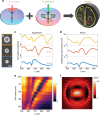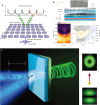Radiationless optical modes in metasurfaces: recent progress and applications
- PMID: 39152114
- PMCID: PMC11329644
- DOI: 10.1038/s41377-024-01548-5
Radiationless optical modes in metasurfaces: recent progress and applications
Abstract
Non-radiative optical modes attracted enormous attention in optics due to strong light confinement and giant Q-factor at its spectral position. The destructive interference of multipoles leads to zero net-radiation and strong field trapping. Such radiationless states disappear in the far-field, localize enhanced near-field and can be excited in nano-structures. On the other hand, the optical modes turn out to be completely confined due to no losses at discrete point in the radiation continuum, such states result in infinite Q-factor and lifetime. The radiationless states provide a suitable platform for enhanced light matter interaction, lasing, and boost nonlinear processes at the state regime. These modes are widely investigated in different material configurations for various applications in both linear and nonlinear metasurfaces which are briefly discussed in this review.
© 2024. The Author(s).
Conflict of interest statement
The authors declare no competing interests.
Figures






Similar articles
-
Meta-optics and bound states in the continuum.Sci Bull (Beijing). 2019 Jun 30;64(12):836-842. doi: 10.1016/j.scib.2018.12.003. Epub 2018 Dec 8. Sci Bull (Beijing). 2019. PMID: 36659673 Review.
-
Bound States in the Continuum in Anisotropic Plasmonic Metasurfaces.Nano Lett. 2020 Sep 9;20(9):6351-6356. doi: 10.1021/acs.nanolett.0c01752. Epub 2020 Jun 10. Nano Lett. 2020. PMID: 32479094
-
Enhanced light-matter interactions in ultrathin transition-metal-dichalcogenide metasurfaces by magnetic and toroidal dipole bound states in the continuum.Opt Express. 2022 Nov 21;30(24):43104-43117. doi: 10.1364/OE.474088. Opt Express. 2022. PMID: 36523016
-
Planar nonlinear metasurface optics and their applications.Rep Prog Phys. 2020 Dec;83(12):126101. doi: 10.1088/1361-6633/abb56e. Rep Prog Phys. 2020. PMID: 33290268
-
Nonlinear Optics in Dielectric Guided-Mode Resonant Structures and Resonant Metasurfaces.Micromachines (Basel). 2020 Apr 24;11(4):449. doi: 10.3390/mi11040449. Micromachines (Basel). 2020. PMID: 32344556 Free PMC article. Review.
Cited by
-
Dual-wavelength multiplexed metasurface holography based on two-photon polymerization lithography.Nanophotonics. 2025 Mar 10;14(5):581-588. doi: 10.1515/nanoph-2024-0705. eCollection 2025 Mar. Nanophotonics. 2025. PMID: 40161537 Free PMC article.
-
Second harmonic generation from bound-state in the continuum-hosted few-layers van der Waals metasurface.Nanophotonics. 2025 Jan 16;14(2):263-270. doi: 10.1515/nanoph-2024-0630. eCollection 2025 Feb. Nanophotonics. 2025. PMID: 39927202 Free PMC article.
References
-
- Limonov, M. F. et al. Fano resonances in photonics. Nat. Photonics11, 543–554 (2017).10.1038/nphoton.2017.142 - DOI
-
- Li, Y. et al. Transforming heat transfer with thermal metamaterials and devices. Nat. Rev. Mater.6, 488–507 (2021).10.1038/s41578-021-00283-2 - DOI
-
- Li, G. X., Zhang, S. & Zentgraf, T. Nonlinear photonic metasurfaces. Nat. Rev. Mater.2, 17010 (2017).10.1038/natrevmats.2017.10 - DOI
Publication types
LinkOut - more resources
Full Text Sources

